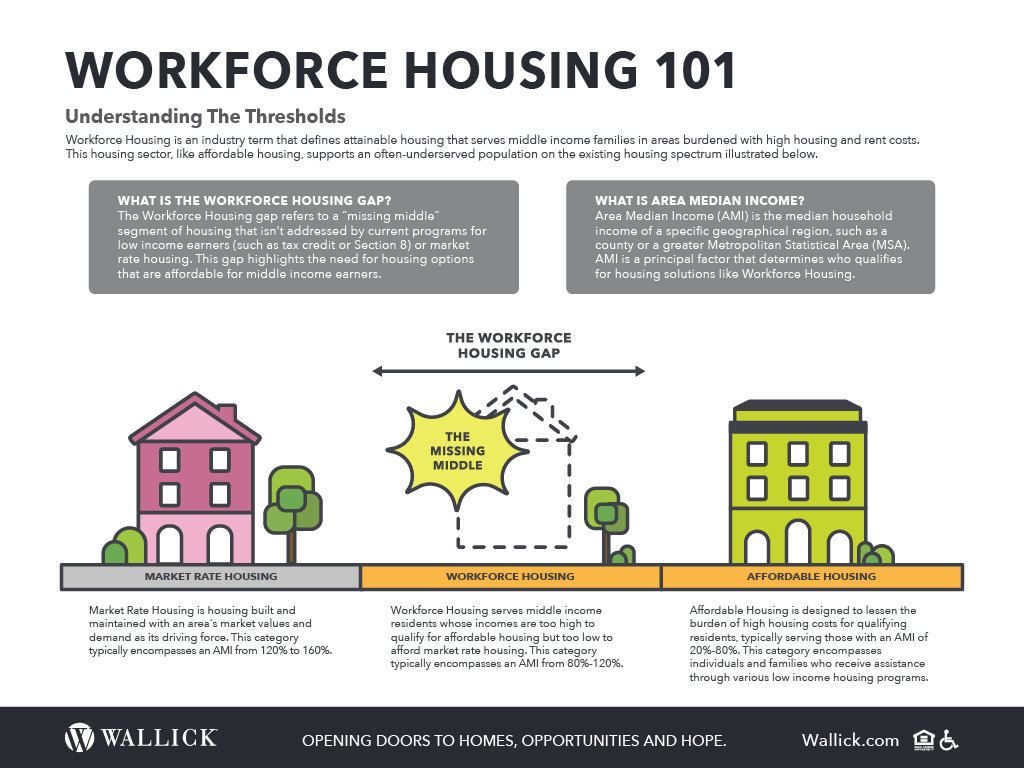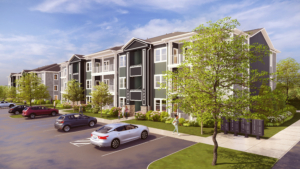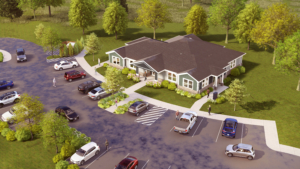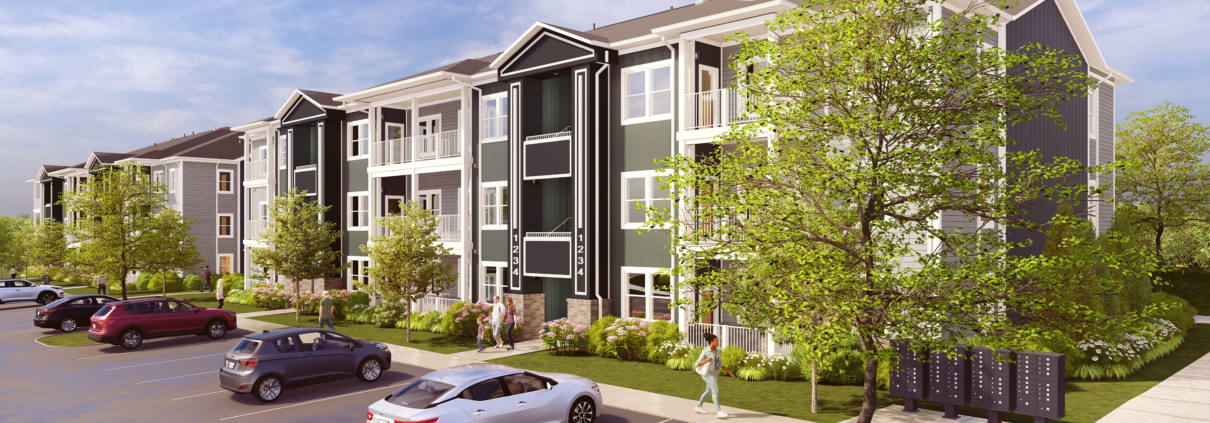Wallick Enters a New Business Market: Workforce Housing
Wallick is excited to announce our entry into Workforce Housing, a housing sector that meets a highly underserved need, as we continue to fulfill our mission of opening doors to homes, opportunities, and hope.
Introduction and Background: What is Workforce Housing?
Workforce Housing lies in between Affordable Housing and Market-Rate Housing on the housing spectrum. This type of housing is crucial in regions burdened by high rent costs and soaring occupancy rates.
Housing costs have significantly increased nationwide. For certain communities (typically urban areas) the rising cost of living, zoning barriers, and insufficient housing availability pose challenges to residents. Middle-income households often find themselves struggling to find or keep suitable housing.
Workforce Housing meets the needs of middle-income families by providing housing that is high-quality and on par with market-rate amenities at a more affordable rate.
The Workforce Housing Gap
Workforce Housing fills a specific gap in the housing market, serving individuals and families with an area median income (AMI) between 80-120%. This is an area often untouched by both affordable and market-rate housing.
- Affordable Housing typically encompasses those within the 0% to 80% AMI.
- Market Rate Housing typically ranges from 120% to 160% AMI.
Barriers to developing Workforce Housing include:
- Increased construction costs
- High interest rates
- Availability of programs that incentivize workforce housing development and help fill financial gaps
- Maintaining rents between 80%-120% AMI
Reliant on complex financing, Workforce Housing requires a high level of creativity and commitment from public and private funding sources working together to prioritize these projects.

Introducing Corners Crossing, Traverse City’s Newest Workforce Housing Community
We are thrilled to introduce Corners Crossing, Wallick’s inaugural Workforce Housing development. Corners Crossing will be a 192-unit community in Traverse City, Michigan. The financing for Corners Crossing officially closed on Friday, June 28, 2024.
In 2022, initial development efforts for Corners Crossing began which resulted in securing support from key project partners:
- Grand Traverse County awarded Wallick $1.5 million at the close of 2022 before the Michigan State Housing Development Authority’s (MSHDA) missing middle funds became available.
- Blair Township granted Wallick a PILOT (Payment in Lieu of Taxes), ensuring real estate taxes for Corners Crossing will never exceed 6% of revenue. This controls our real estate tax payments, so they are more predictable, allowing us to better manage expense loads.
- Wallick partnered with HomeStretch Nonprofit Housing Corp., a like-minded, mission-driven nonprofit developer local to the Traverse City community.
These initial efforts allowed Wallick to then apply to MSHDA for funding made possible through the American Rescue Plan (ARPA) federal stimulus program. In July 2023, Wallick was awarded $5 million to finance Corners Crossing’s construction through these aptly named “missing middle” dollars that MSHDA distributed to planned Workforce Housing projects throughout the state of Michigan.
Additional project financing partners include the U.S. Department of Housing and Urban Development (HUD), Greystone, and Huntington.

Rendering of Corners Crossing: Clubhouse Aerial View

Rendering of Corners Crossing: Walk-Up Perspective
Michael DiCarlantonio, Vice President of Development, and John Marra, Senior Development Manager, took the lead in Wallick’s application for these highly competitive funds, resulting in Wallick receiving one of the highest dollar awards among all applicants. Notably, Wallick was the sole out-of-state applicant to receive Grand Traverse County’s ARPA dollars.
Wallick’s entry into Workforce Housing coincided with our first construction in the Traverse City area, Meadow Valley. In 2018, we began development on Meadow Valley. During the pandemic, a need arose to collaborate with Grand Traverse County’s Board of Commissioners to leverage municipal bonds for the funding of the project. It was through this process that the Development Team learned of Grand Traverse County’s urgent need for affordable multifamily housing.
Traverse City, known for its tourism, has struggled to keep its workforce locally due to the high housing costs and elevated rents. With occupancy rates rising to 100%, it’s one of the Midwest’s most expensive markets.
By staying engaged with Grand Traverse County and recognizing the demand for affordable multifamily housing, Wallick was prepared to be a creative part of the solution when the county directed its resources toward making Workforce Housing a primary funding focus.
We congratulate Michael and John for successfully securing the funding resources to make Corners Crossing a reality. This community fulfills high demand, allowing middle-income families who work in Traverse City to live within the community.
“Wallick has always been a provider of attainable housing for all and is responding to the housing crisis facing our middle-income families with our foundation of experience in finding creative and complex financing solutions to make it happen,” says Alexis Dunfee, Senior Vice President of Development at Wallick Communities.
Wallick’s Future with Workforce Housing
For years, Wallick has strategically focused on the Central Ohio region and now with continued pressure on the housing market and the arrival of Intel, there is an incredibly pressing need for new Workforce Housing projects. In tandem with current projects, Wallick has actively championed local Workforce Housing solutions. Key members of our team have collaborated with like-minded community leaders, testified before state committees, and established vital relationships with government bodies to secure funding and support for these crucial projects.
Most recently, Wallick’s Central Park project, a mixed-use development in Heath, OH, was one of 15 developments awarded $4.1 million from a highly competitive pool of state tax credits for Ohio’s Transformational Mixed-Use Development (TMUD) Program. Wallick is developing 47 acres of this 300-acre site for workforce housing.
Central Park aims to invigorate the City of Heath with a new downtown area consisting of 42,000 square feet of commercial retail space expected to be occupied by shops, offices, restaurants and breweries, along with walking trails and a community pool. Phase II of the development entails the construction of over 580,000 square feet among 24 buildings, including 21 multifamily workforce housing buildings, along with two restaurants and an assisted living community.
Looking ahead, Workforce Housing is highly individualized to a community, and there is no one-size-fits-all project formula. The ARPA dollars secured for Corners Crossing were limited funds specifically designed to meet the needs within the State of Michigan and Traverse City, as were the Ohio Department of Development’s Transformational Mixed-Use Development tax credits. A localized, collaborative approach will continue to be needed for any future Workforce Housing endeavors.
Nonetheless, our core values of genuine care, character and collaboration extend to the communities we serve, and we look forward to continuing to provide safe and secure housing for the families who need it most through our Workforce Housing efforts.



